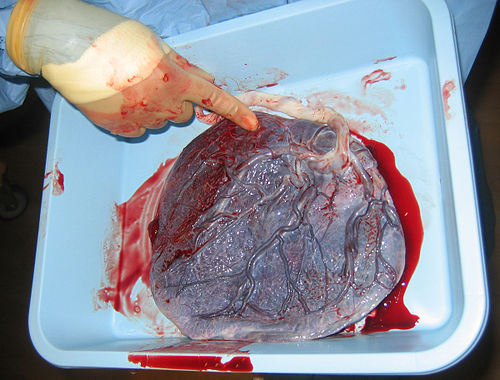Chorionnoun
The protective and nutritive membrane in higher vertebrates that attaches the fetus to the uterus.
Chorionnoun
The outer case of an insect egg.
Chorionnoun
(botany) The outer membrane of seeds of plants.
Chorionnoun
The outer membrane which invests the fetus in the womb; also, the similar membrane investing many ova at certain stages of development.
Chorionnoun
The outer membrane of seeds of plants.
Chorionnoun
outermost membranous sac enclosing the embryo in higher vertebrates (reptiles, birds and mammals)
Chorion
The chorion is the outermost fetal membrane around the embryo in mammals, birds and reptiles (amniotes). It develops from an outer fold on the surface of the yolk sac, which lies outside the zona pellucida (in mammals), known as the vitelline membrane in other animals.
Placentanoun
(anatomy) A vascular organ in mammals, except monotremes and marsupials, present only in the female during gestation. It supplies food and oxygen from the mother to the foetus, and passes back waste. It is implanted in the wall of the uterus and links to the foetus through the umbilical cord. It is expelled after birth.
Placentanoun
(botany) In flowering plants, the part of the ovary where ovules develop; in non-flowering plants where the spores develop.
Placentanoun
The vascular appendage which connects the fetus with the parent, and is cast off in parturition with the afterbirth.
Placentanoun
The part of a pistil or fruit to which the ovules or seeds are attached.
Placentanoun
that part of the ovary of a flowering plant where the ovules form
Placentanoun
the vascular structure in the uterus of most mammals providing oxygen and nutrients for and transferring wastes from the developing fetus
Placentanoun
a flattened circular organ in the uterus of pregnant eutherian mammals, nourishing and maintaining the fetus through the umbilical cord.
Placentanoun
(in flowers) part of the ovary wall to which the ovules are attached.
Placenta
The placenta is a temporary fetal organ that begins developing from the blastocyst shortly after implantation. It plays critical roles in facilitating nutrient, gas and waste exchange between the physically separate maternal and fetal circulations, and is an important endocrine organ producing hormones that regulate both maternal and fetal physiology during pregnancy.

















